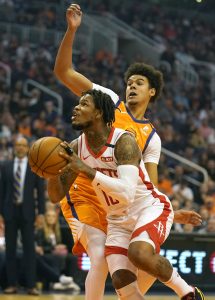It’s March 2, which means that a player waived by an NBA team today, tomorrow, or on any day before the end of the 2019/20 regular season won’t retain his postseason eligibility. The league’s rules state that a player must be released by the end of the day on March 1 in order to be playoff-eligible for a new team.
For the most part, this means that a player who is on one NBA roster today can’t suit up in the postseason for a different team, though there are a few exceptions to that general rule. Those exceptions apply to players currently on 10-day contracts: Donta Hall (Pistons), Dragan Bender (Warriors), Mychal Mulder (Warriors), and Jarrod Uthoff (Grizzlies).
If, for instance, Bender’s 10-day deal with Golden State expires on Tuesday night and he subsequently signs with a playoff team, he’ll be eligible to participate in the postseason, since he wasn’t released from a standard NBA contract after March 1.
It’s also worth clarifying that a player didn’t have to sign with a new team by March 1 to be playoff-eligible — he simply had to be placed on waivers or reach free agency by Sunday night. As long as a player who fits that bill signs with a new team by April 15, the final day of the regular season, he can play in the postseason.
As our recap of the 2020 buyout market shows, several players have been bought out or released since the trade deadline and joined new teams, including Marvin Williams (Hornets to Bucks), Reggie Jackson (Pistons to Clippers), Markieff Morris (Pistons to Lakers), and a handful of others. They’ll all be postseason-eligible.
Several players were also waived in recent weeks but haven’t yet lined up new teams, including Tyler Johnson, Isaiah Thomas, and Dion Waiters, among others. If they do sign with a new club anytime between now and April 15, they’ll be eligible to participate in the playoffs too. The same goes for players who haven’t played at all in the NBA this season, such as J.R. Smith and Joakim Noah.
The Nuggets have yet to announce the release of Jordan McRae, and that move isn’t yet showing up in NBA.com’s official transactions log, but I’d be surprised if it didn’t technically happen on Sunday night. That would allow McRae to retain his playoff eligibility as he prepares to join the Suns, who still have an outside shot at the postseason.
McRae and Lakers guard Troy Daniels were the last two vets released on Sunday, after Allen Crabbe (Timberwolves) and Anthony Tolliver (Kings) were waived on Saturday.
 Ben McLemore
Ben McLemore Rookie wing
Rookie wing